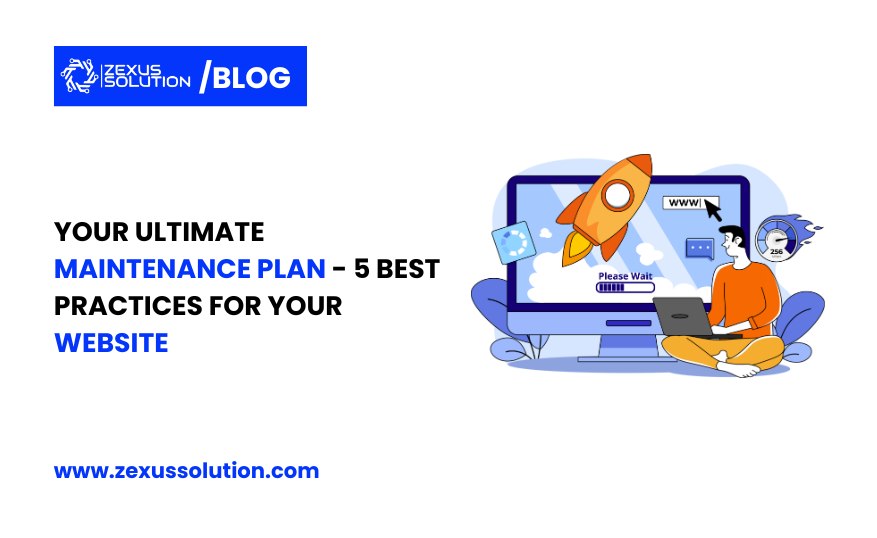Table of Contents
Maintenance is necessary in everything. Whether it’s your car, your health, your business, or your website, regular updates keep things running smoothly. Just like you’d schedule a tune-up for your car or a check-up for your health, dedicating time to maintaining your website prevents issues from snowballing into bigger, costlier problems. To remain relevant and secure, a website needs updates, security checks, and content refreshes.
Even small businesses need maintenance plans for websites, as they are often seen as easy targets for hackers and viruses. Unlike large companies, small businesses do not have the capability of maintaining large cybersecurity teams. Sometimes, when the threat is identified, it may not be responded to promptly as a small business may not have the capabilities to do so. Hackers know this and can use vulnerabilities in outdated software, weak passwords, or any unsecured plugins to enter their sensitive information.
Why Should You Invest in Website Maintenance?

Web application maintenance services are essential for the growth of your business. An effective maintenance plan lets you adapt to new technologies and market necessities. It will keep your business competitive by using new functionality, and design elements, and making sure that your app stays updated with new browsers. In addition, maintenance updates will keep your online presence high as they help to maintain the effectiveness of SEO since search engines favor those websites that are regularly updated and remain user-friendly.
Benefits of Website Maintenance
Website maintenance services hold the power to make or break your business impression. There are several benefits of maintaining your website regularly:
- Regular maintenance updates your website and runs it seamlessly by optimizing images, cleaning up unused codes, and breaking broken links to ensure a smooth user experience.
- Web maintenance ensures a responsive site to optimize the functionality when accessed through mobiles, an important element in retaining customers in today’s world of mobiles.
- Web maintenance services ensure that no broken link exists, giving users a hassle-free experience and, in general, better overall satisfaction with the website.
- The well-maintained website will ensure better SEO optimization, which will increase the visibility of the website towards the natural flow of traffic to it.
- It maintains consistent branding elements on all its platforms, thus continuously reinforcing its brand identity and gaining trust with one’s audience.
- By investing in trusted web maintenance services, you will be preventing income loss due to downtime or performance problems and hence your business will be running smoothly and effectively.
5 Best Practices for Your Website

1. Regular Updates and Security Patches
Why: Hackers take advantage of many open holes in old software, plugins, and themes. When security flaws are discovered, developers apply updates to patch them. If your website isn’t updated regularly, you open it up to destructive users who could execute data breaches, deface the site, or shut down a whole site. Keeping it all up to date strengthens not only the security but goes on to optimizes performance and ensures compatibility with other software. This is one of the key application maintenance best practices that can safeguard your site.
Implementation: Plan for your website to be checked at least every two weeks or monthly to update all components of your website – content management system (e.g., WordPress), plugins, themes, and other integrations. Most sites are set up to send you automated notices that an update is available, and some critical plugins and security patches can be set to auto-update, thus saving you the time that would have to be spent on checking. For each update, one has to check up on the site to ascertain that everything is compatible and works well, especially when custom-coded elements are involved.
2. Scheduled Backups

Why: Sites should be backed up regularly, ensuring there is an easy way to restore a hacked or lost data website. Accidents, cyber-attacks, and even simple user errors can result in the deletion or corruption of data. Backups are like insurance policies, they make sure you get back to a previous version of your website if something goes wrong.
Implementation: Automatic backups should be implemented daily or weekly depending on the update frequency of your site content. The service selected for backing up your website into offsite or cloud-based storage should assure reliability regarding data safety to avoid losing your data in the event of localized failure. Frequent restores should be done in a staging environment, testing for the completeness and ease of reinstallment of those backups. To further secure them, keep several copies of the backups; one should be placed in another location, and successful backups should trigger email alerts.
3. Monitor the site’s performance and speed.
Why: A fast, smoothly running website enhances user experience and gets a boost from search engines with higher rankings. Slow load times infuriate users, which increases bounce rates and possibly lost business. Having the capacity to identify issues that slow down the site-whether it’s heavy images, unnecessary plugins, or outdated through regular web app maintenance is sure to help you address these issues effectively.
Implementation: Use Google PageSpeed Insights or GTmetrix to monitor your site regularly. Both websites deliver fantastically detailed analyses of page load speed in addition to extremely specific recommendation areas for improvement, such as which images can be optimized, how many HTTP requests may be reduced, and where available JavaScript or CSS bloat could be reduced. Finally, take a close look at your plugin usage: remove any that seem unnecessary and those that duplicate functionality, and optimize your site’s caching settings to make sure that returning visitors see the page load quickly.
4. Optimize for SEO and Quality Content

Why: It is important for optimizing SEO to boost organic traffic and make the content crawlable, understandable, and rankable by search engines. In addition, re-updating your content and best SEO practices will keep your site competitive on search rankings, which leads to steady streams of visitors. This also gives your site credibility and keeps your visitors engaged.
Implementation: Perform routine SEO audits checking for broken links, keyword obsolescence, and missing metadata. Update the content on your website with relevant keywords and ensure every page is optimized with user-friendly, informative, and engaging content. Fix your broken links effectively and refresh any older content piece with recent statistics or insights. This alone will boost your SEO ratings, but you’ll also place your site front and center as current and reliable.
5. Implement Strong Security Measures
Why: A secure website would give users trust and save your business from potential data breaches and other cyber threats. Without strong security, your site can get hacked and become vulnerable to malware injections or even data theft. Methods of security include SSL certificates, two-factor authentication, and malware scans to keep your environment safe for you and your visitors.
Implementation: Turn on SSL certificates to ensure encrypting sensitive data and strong, hard-to-guess passwords are used for all accounts. Deploy malware and other security vulnerabilities scanning software or plugins that scan your website regularly. Implement two-factor authentication over admin access, and if possible, a website firewall for filtering out malicious traffic. Routine security checks and audits will keep you one step ahead of emerging threats and keep your site protected.



Add a Comment